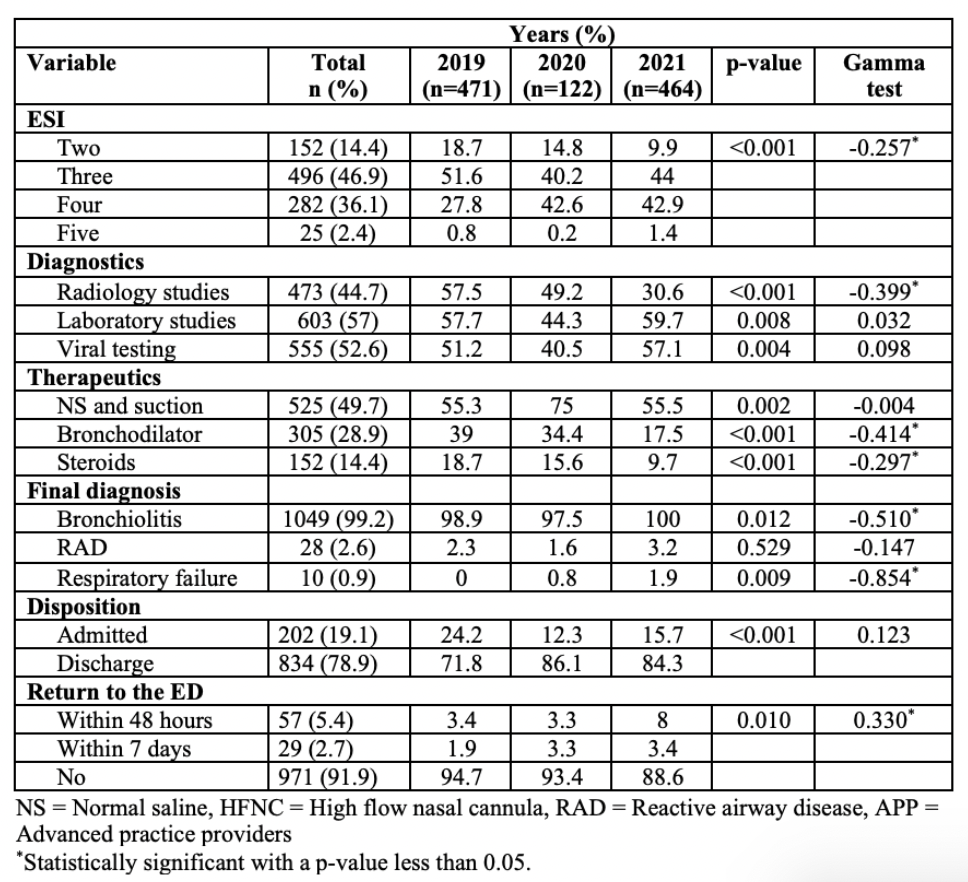Emergency Medicine: All Areas
Emergency Medicine 4
74 - Changes in Bronchiolitis Characteristics during the COVID-19 pandemic: a description of pediatric emergency department visits in a community hospital, 2019-2021
Publication Number: 74.112

Anna M. Jurlina, B.S. (she/her/hers)
Medical Student
University of Central Florida College of Medicine
Orlando, Florida, United States
Presenting Author(s)
Background: The SARS-CoV-2 (Coronavirus disease 2019 [COVID-19]) pandemic affected the epidemiology of respiratory viruses. During the pandemic, there was an average drop of 84% in acute bronchiolitis cases managed in the Emergency Department (ED), partly attributable to the adopted security measures.
Objective: The objective of this study is to describe bronchiolitis’ characteristics of cases that visited the ED through the COVID-19 pandemic.
Design/Methods: We performed a retrospective, cross-sectional study of children diagnosed with bronchiolitis aged one to 24 months during an ED visit between January 2019 and December 2021. Data included age, past medical and family history, emergency severity index (ESI), management, and disposition. Chi-square or Kruskal-Wallis was used as appropriate. Gamma coefficient was used to measure the association of variables through time. A p less than 0.05 was established as statistically significant.
Results:
We included 1057 patients, with a median age of 8.4 months (IQR 4.8-13.2). Bronchiolitis cases decreased by 75% from 2019 (471) to 2020 (122) and increased to pre-pandemic levels by 2021 (464). There was a decreasing trend in the past medical history for allergies and previous bronchiolitis episodes (gamma -0.656, p< 0.001). ESI two and three decreased, while ESI four and five increased during the study period (gamma -0.257, p< 0.05). The use of radiographs (gamma -0.399), steroids (gamma -0.297), bronchodilators (gamma -0.414) decreased during the study period (p< 0.05). Laboratory studies (gamma 0.032), viral testing (gamma 0.098), antibiotic use (gamma 0.069), and respiratory support (gamma 0.177) increased, albeit not significantly (p >0.05). The most common organism was respiratory syncytial virus (gamma 0.057, p< 0.05). Median length of stay in the ED was 168 minutes (IQR 120-236). About 1% of patients were admitted to intensive care (gamma -1.0, p< 0.05), while most patients were discharged home (gamma 0.123, p >0.05).
Conclusion(s):
Safety measures implemented during the COVID-19 pandemic helped curb the transmission of respiratory viruses that cause bronchiolitis. The decreased use of steroids and bronchodilators may be related to the implementation of a clinical pathway that discouraged their use. The use of respiratory support increased throughout the study period but did not reach significance. Although more patients were admitted to intensive care in 2021, the ESI showed a decreasing trend in ESI two/three and increase in four/five, suggesting decreased disease severity. .png)


